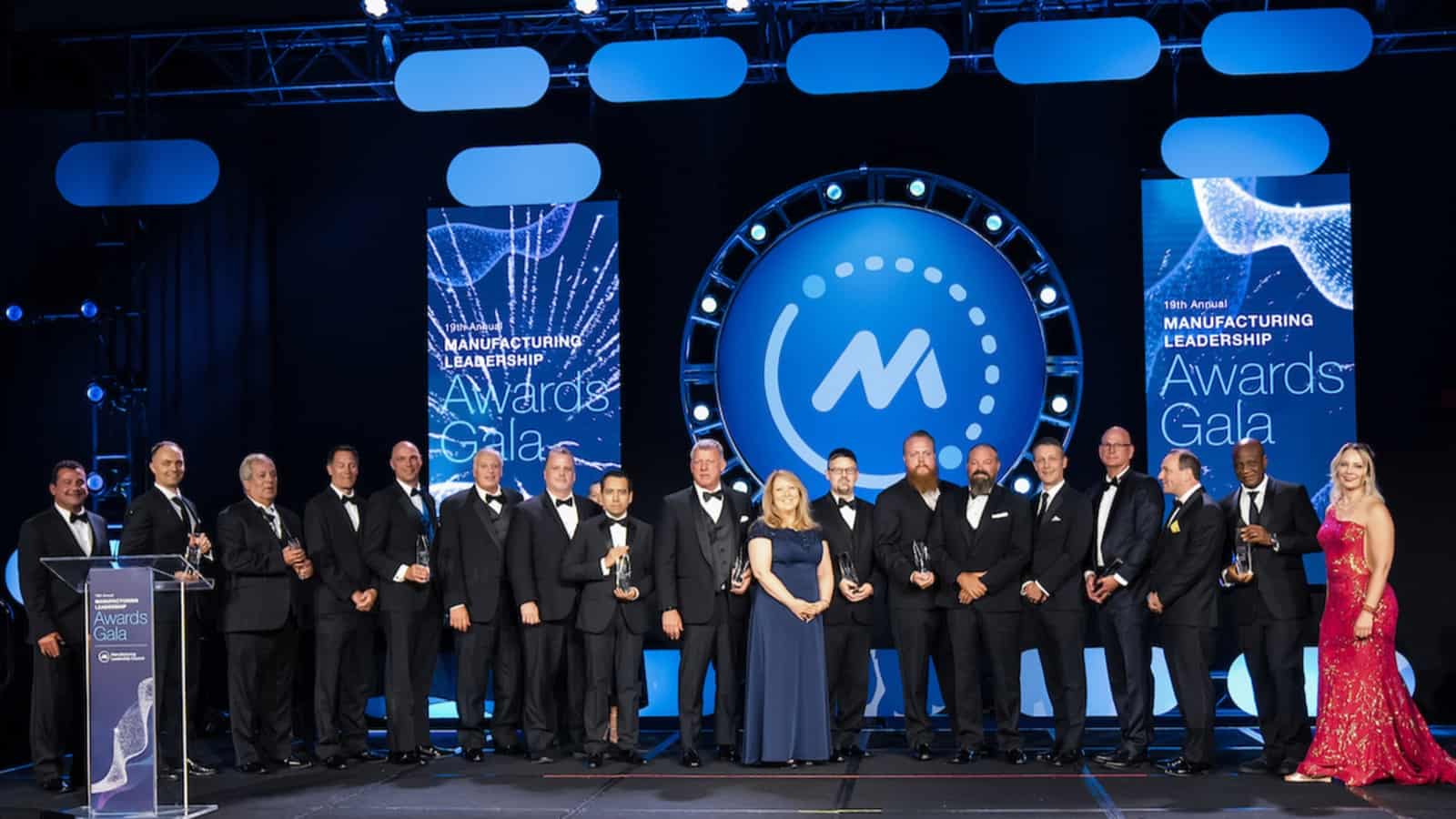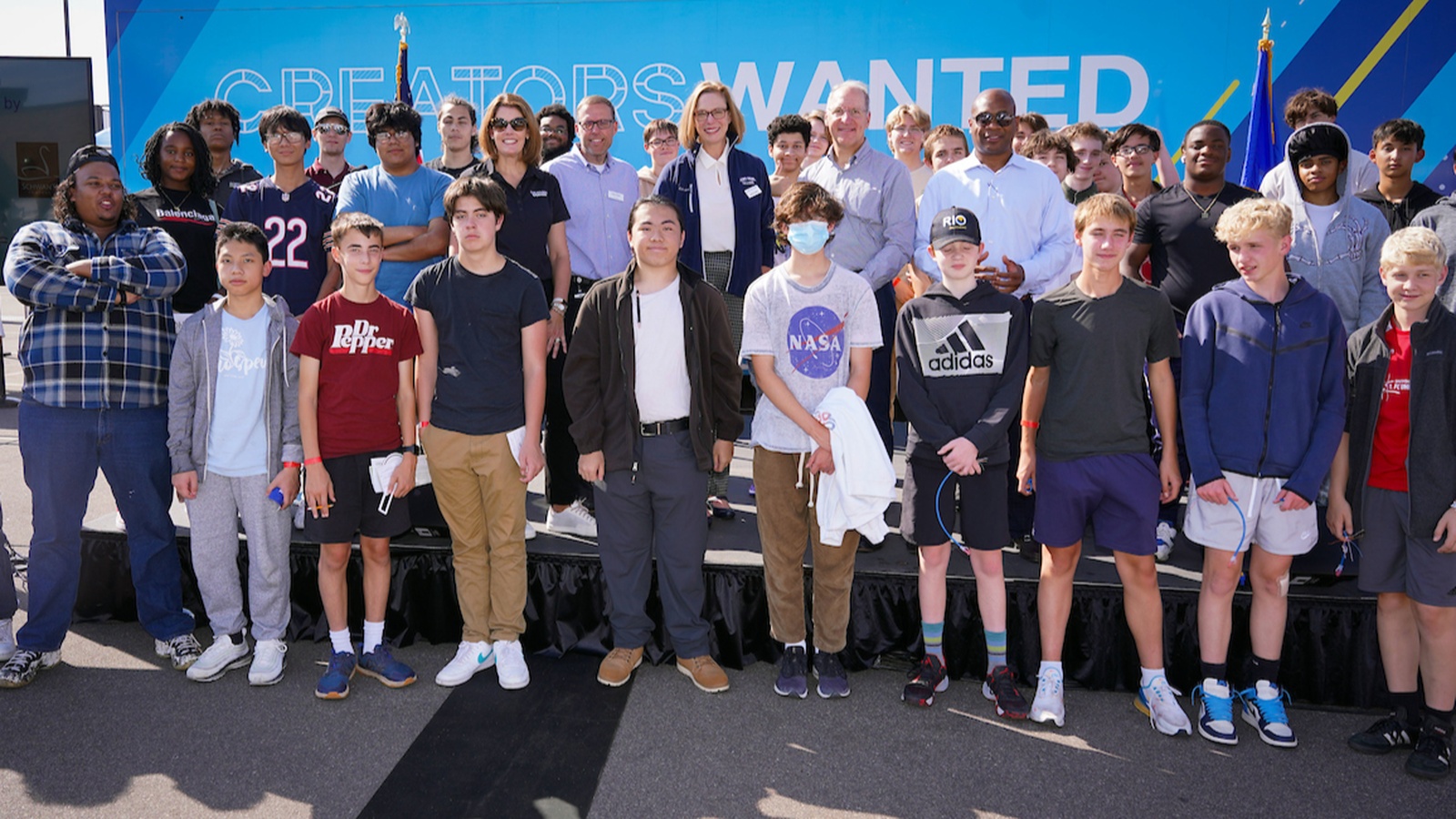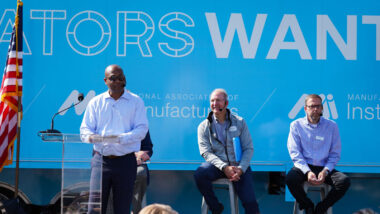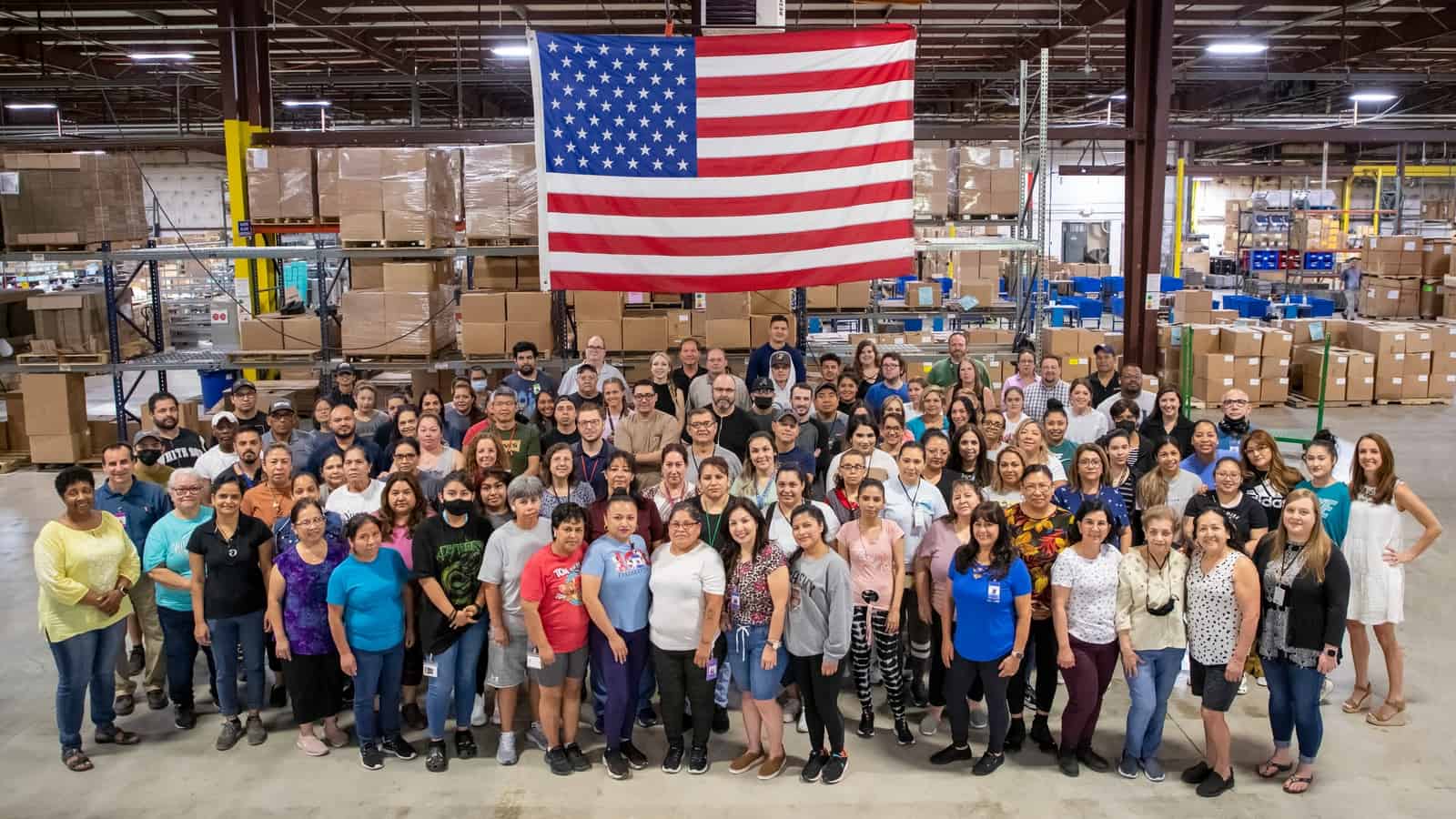Commerce Updates Chip-Export Restrictions

The Biden administration announced broad updates to restrictions on U.S. exports of advanced computing and semiconductor-making equipment to China, according to Reuters (subscription).
What’s going on: “The measures are designed to prevent China from acquiring the cutting-edge chips needed to develop AI technologies such as large language models, which power applications such as ChatGPT but that U.S. officials say also have military uses that present a national security threat.”
- The updated interim final rules announced on Oct. 17 will go into effect Nov. 17 and will “reinforce the October 7, 2022, controls to restrict [China]’s ability to both purchase and manufacture certain high-end chips critical for military advantage,” according to a press release from the Commerce Department’s Bureau of Industry and Security.
Why it matters: “These controls were strategically crafted to address, among other concerns, [China]’s efforts to obtain semiconductor manufacturing equipment essential to producing advanced integrated circuits needed for the next generation of advanced weapon systems” and other technologies that “present U.S. national security concerns,” according to the BIS.
- In an effort to control a wider range of chips, Tuesday’s rules will focus on computing power only and will require companies to notify the U.S. government when they sell chips that come in just under restriction limits.
“Chiplets”: The rules also seek to address “chiplets,” in which small portions of a chip are spliced to make a full chip.
- “Analysts had expressed concern that Chinese firms could use such technology to acquire chiplets that stayed within the legal limits but that could later be assembled in secret into a larger chip that would break the rules,” according to Reuters.
The last word: “By imposing stringent license requirements, we ensure that those seeking to obtain powerful advanced chips and chip manufacturing equipment will not use these technologies to undermine U.S. national security,” said Assistant Secretary of Commerce for Export Administration Thea D. Rozman Kendler.
Creators Wanted Tour Culminates at Pumpkin Show

The Creators Wanted campaign—an initiative of the NAM and the Manufacturing Institute aimed at driving excitement about modern manufacturing careers—is concluding the wildly successful run of its immersive experience with a significant finale at the Circleville Pumpkin Show, one of the largest annual festivals in the country.
By the numbers: Since it began last year, Creators Wanted has created quite a stir.
- More than 13,000 students, educators and community leaders have engaged with the tour directly.
- Online, 1.5 million students and mentors have signed up to explore modern manufacturing careers.
- A whopping 84% of tour participants now view manufacturing careers more positively.
- Positive industry perception among parents has jumped nationwide from 27% to 40%, thanks in part to the tour and associated MI programs.
Watch a recap of the tour featuring the voices of students, educators and parents who share their perspective on the tour’s impact.
Next week: From Oct. 17–21, half a million attendees, including families and students, will have a chance to experience the tour’s immersive setup, a featured event at this year’s show.
- Manufacturing team members from the Honda and LG Energy Solution joint venture (the tour stop’s sponsor) will be present, offering insights into modern manufacturing careers.
- The Creators Wanted online training program and jobs resource will be showcased, and the tour will engage with local schools, particularly STEM students, amplifying the opportunities in manufacturing.
The big picture: With industries vying for the best talent amid continued labor challenges, initiatives like the Creators Wanted Tour play an essential role in reshaping public perceptions and attracting the next generation into manufacturing over other potential career options.
What’s next: “Now, we know our work is far from over, and so our work goes on with the MI, building on this momentum, along with Creators Wanted digital resources, ” said NAM President and CEO Jay Timmons, who also serves as chairman of the board of the MI.
Startup Aims to Make Green Hydrogen Affordable

An energy startup that just hit the $1 billion investment mark thinks it holds the key to finally producing large quantities of “green” hydrogen, according to The Wall Street Journal (subscription).
What’s going on: “Electric Hydrogen believes the secret to success is finding a better way to split a [water] molecule. … Splitting it to create green hydrogen requires devices called electrolyzers. They are expensive and consume vast amounts of renewable electricity to make a small amount of hydrogen, making most projects uneconomical. Electric Hydrogen says its electrolyzer can produce much more hydrogen.”
- The company says its method of hydrogen production combined with “the generous tax subsidies on offer” from last year’s Inflation Reduction Act could finally make green hydrogen a market-competitive energy source.
Investors go all in: The company “recently raised $380 million from backers including BP, United Airlines, Microsoft and iron-ore producer Fortescue Metals,” helping it pass $1 billion in total investments.
Why it’s important: Green hydrogen “is one of the few options to eliminate emissions from trucks, planes, steel mills and chemical plants where renewable power and batteries alone can’t get the job done.”
- “Hydrogen is one of the few ways to move green power long distances. Potential demand is so great that the winner of the race for green hydrogen could dominate a market worth as much as $1 trillion in the coming decades.”
Cracking the code: While electrolyzers have been typically small devices used in the aerospace and chemical industries, Electric Hydrogen thinks it can make the devices both larger and more affordable “by starting from scratch and using new plate engineering focused on the performance of bigger electrolyzers.”
The NAM’s take: “Clean hydrogen is critical to decarbonizing hard-to-abate industries, and manufacturers are leading the way in developing and scaling it for widespread use,” said NAM Vice President of Domestic Policy Brandon Farris.
- “The NAM is working to ensure that the incentives available for clean hydrogen help create the right market incentives for producers—as well as manufacturers and other end users—to meaningfully contribute to decarbonization while boosting domestic job growth and global competitiveness.”
Manufacturing Leadership Awards Kick Off 20th Season

For two decades, the Manufacturing Leadership Awards have recognized outstanding manufacturing companies and their leaders for their groundbreaking use of advanced manufacturing technology. What started out in 2005 as a modest 50-person gathering in New Orleans has evolved into one of the industry’s most exciting celebrations.
This past June, the Manufacturing Leadership Awards Gala honored an impressive 163 projects and leaders, in front of an electrified crowd of 450 guests. The program’s growth is a testament to the momentum of Manufacturing 4.0 technologies and their success in creating performance improvements and boosting competitiveness.
With more manufacturers adopting digital and data-driven methods every day, there is still much to celebrate. The program’s 20th season is now open for nominations, with expectations running high for another amazing show in 2024.
A proud heritage: Past winners from the Manufacturing Leadership Awards include companies and leaders from nearly every industry, from 10-person shops to multinational enterprises, located all around the world.
- Each entry is reviewed by a judging panel made up of industry experts with extensive experience in technology transformation. The top-scoring projects are selected as category finalists, and the category winners are revealed at the awards gala.
- Finalists and winners report that the awards have helped them gain new customers, boosted employee morale and team camaraderie and encouraged their executive leadership to continue investing in digital technology initiatives.
- Since the program’s inception, more than 1,000 leaders and projects have been honored for their achievements.
A wide range of candidates: The awards program welcomes submissions from small and medium-sized enterprises, as judges look for the overall level of impact that projects have had on a company’s operations—not the dollar amount of their investments.
- If technology has measurably helped a company improve its operational performance, upskill employees or enter new business markets, those projects are excellent candidates for award nominations.
The categories: Over the years, the awards have encompassed an evolving list of categories, currently at nine for projects and two for individuals.
- Project categories include AI and Machine Learning, Collaborative Ecosystems, Digital Network Connectivity, Digital Supply Chains, Engineering and Production Leadership, Enterprise Integration and Technology, Operational Excellence, Sustainability and the Circular Economy, and Transformational Business Cultures.
- Individual categories include Digital Transformation Leadership, for established manufacturing operations executives who lead Manufacturing 4.0 initiatives, and Next-Generation Leadership, for up-and-coming operations leaders aged 30 or younger.
Get involved: All manufacturers in any location and of any organizational size are eligible and encouraged to apply. Program details, rules and instructions for how to submit a nomination are available on the MLC website. Entries are due Jan. 17, 2024.
NAM Strengthens Policy Expertise with New Leadership
Washington, D.C. – The National Association of Manufacturers announced the promotion of Charles Crain as its new vice president of domestic policy. Crain previously served as the NAM’s senior director of tax and domestic economic policy, where he led successful policy efforts on a range of tax and corporate governance issues.
In this new role, Crain leads the association’s focus on a range of priorities, including advancing competitive tax and corporate finance policies, pushing back against the regulatory onslaught facing the industry and advocating policies that strengthen manufacturers’ ability to develop lifesaving treatments. He will also bring together the expertise of the NAM’s Manufacturing Leadership Council and Innovation Research Interchange to drive the debate around the role of AI and technology in the future of manufacturing.
In addition to Crain, the lead policy experts for the association include Vice President of Domestic Policy Brandon Farris, who leads the energy, sustainability, labor and infrastructure policy portfolio; Vice President of International Policy Ken Monahan; and Chief Economist Chad Moutray. In July, Managing Vice President of Policy Chris Netram took the helm of the policy division.
“The NAM’s best-in-class policy team is made stronger with the elevation of Charles Crain. Charles has a track record of success that has benefitted manufacturers, and they will benefit even more from his leadership in this new role. As technology continues to play an increasingly critical role in manufacturing, Charles will be a leading voice in ensuring policymakers foster an environment where our industry can stay globally competitive,” said NAM President and CEO Jay Timmons. “Moreover, the integration of policy, government relations, communications, public affairs and brand strategy within the NAM ensures that manufacturers will be a driving force inside and outside the Beltway on every issue important to the industry.”
“Charles’ new role ensures that manufacturers will have an experienced advocate who can move the needle in debates on tax, health care, corporate finance, regulatory reform and technology policy. These critical issues are key to manufacturing competitiveness,” said Netram.
-NAM-
The National Association of Manufacturers is the largest manufacturing association in the United States, representing small and large manufacturers in every industrial sector and in all 50 states. Manufacturing employs nearly 13 million men and women, contributes $2.91 trillion to the U.S. economy annually and accounts for 55% of private-sector research and development. The NAM is the powerful voice of the manufacturing community and the leading advocate for a policy agenda that helps manufacturers compete in the global economy and create jobs across the United States. For more information about the NAM or to follow us on Twitter and Facebook, please visit www.nam.org.
Creators Wanted and Union Pacific Dazzle the Twin Cities

Last week, Saint Paul College in St. Paul, Minnesota, which boasts a student body that is 65% people of color, became the 19th stop of 20 for the Creators Wanted Tour, a joint project of the NAM and the Manufacturing Institute, the workforce development and education affiliate of the NAM.
Over three days, with Union Pacific as the lead sponsor, the stop drew more than 600 visitors, from students to educators. Meanwhile, 42,000 online signups in Minnesota helped the campaign surpass 1.5 million nationwide from students and career mentors interested in modern manufacturing careers.
Twin Cities kickoff: Union Pacific Executive Vice President of Marketing and Sales Kenny Rocker gave the keynote address at the kickoff event, emphasizing the reward of manufacturing careers. He was joined by MI President and Executive Director Carolyn Lee, Saint Paul College President Dr. Dee Dee Peaslee, Minnesota Chamber of Commerce President and CEO Doug Loon and Trane Technologies Vice President of Product Management Dave Molin.
keynote address at the kickoff event, emphasizing the reward of manufacturing careers. He was joined by MI President and Executive Director Carolyn Lee, Saint Paul College President Dr. Dee Dee Peaslee, Minnesota Chamber of Commerce President and CEO Doug Loon and Trane Technologies Vice President of Product Management Dave Molin.
- “When I talk about opportunities, I’m talking about really good-paying jobs … At Union Pacific, we’re talking jobs that are … averaging over $100,000 a year, and that’s without benefits, and so you just really have an opportunity to make an impact from that perspective,” said Rocker.
- “At Trane Technologies, our vision is to boldly challenge what’s possible for a sustainable world,” added Molin. “It is the engine of our company, and we live it every day. And to do that, we need bright minds and the best minds in the world. We need diverse thinkers, we need creators, and our doors are open to everyone.”
- Notably, leaders from key government business and workforce partner organizations attended the kickoff, including the Minnesota State Advanced Manufacturing Center of Excellence, Minnesota Black Chamber of Commerce, Minnesota Parent Union and St. Paul Area Chamber, representatives from the offices of U.S. Reps. Brad Finstad (R-MN-1), Angie Craig (D-MN-2), Dean Phillips (D-MN-3), Betty McCollum (D-MN-4) and Michelle Fischbach (R-MN-7), Mayor of South St. Paul Jimmy Francis and State Reps. Jon Koznick (R), Emma Greenman (D) and Samantha Sencer-Mura (D).

Experience and exploration: Students delved deep into immersive activities, from solving manufacturing-related puzzles in the Creators Wanted mobile experience to virtually navigating a locomotive through Union Pacific’s simulators. Equally captivating was the sight of the actual railroad track, which was complemented by insightful career anecdotes from Union Pacific professionals.
- Eighty-seven percent of students surveyed reported a significantly improved view of modern manufacturing careers after completing the immersive experience.
Live Q&A sessions: The stop also offered structured opportunities for students to learn about manufacturing organizations’ support for the next generation of talent, along with the importance of mentorship and personal development in shaping successful careers.
- The first session, featuring two Union Pacific senior managers—Amy Bang, Sr. manager of diversity and inclusion, and Ken Kuwamura, Jr., manager of talent acquisition—and Saint Paul College instructors, zeroed in on the crucial roles of mentorship, diversity and passion in career selection.
- The second session, with Jake Yernberg, automotive instructor, Saint Paul College; Caitlin Bundy, manager of corporate sustainability, Union Pacific; and Preeti Subramanian, senior product manager, Trane Technologies, accentuated the pivotal role of manufacturing in tackling global challenges. Panelists pointed out the advantages of the manufacturing sector, citing competitive pay and the sector’s potential in addressing global issues, such as sustainability and climate change.
Interactive Learning: Everfi®, Ecolab and Schwan’s joined Union Pacific in bringing in representatives to give students career advice—and offer activities to spark their curiosity.
- Everfi® showcased a new digital education program, “Future Creators,” co-developed with the MI and Union Pacific, to give middle and high school students a peek into STEM careers.
- Saint Paul College also took students on a tour of its robust Trades and Technical Education program.
Beyond the Tour: The Twin Cities event is a part of Union Pacific’s overarching “Careers on Track” initiative, which aims to inspire more women and youth to pursue modern industrial careers, and the Creators Wanted campaign’s sustained drive to enhance perceptions of manufacturing careers in the United States and empower more people to create the future.
The last word: “I want all of you out here, the students, to have an opportunity to go out there and win and compete and further your careers and do well in life,” said Rocker, echoing a theme the Creators Wanted Tour has promoted since its inception: manufacturers and manufacturing care about students and their future.
Next up: The pioneering Creators Wanted Tour concludes next month, Oct. 17–21, at the Circleville Pumpkin Show in Circleville, Ohio.
A Footwear Company Strives for Circularity

Within the footwear business, Okabashi is unique. The company, based in Buford, Georgia, is not only a family-owned company focused on sustainability, but also, according to the company’s leadership, producing part of the 1% of footwear still made in the United States.
For third-generation shoemaker Sara Irvani, this choice to build a sustainable and successful business in the U.S. was made possible only thanks to constant research and development.
The backstory: Irvani’s family started the company 40 years ago, and it always tried to reduce waste, both for the positive environmental impact as well as to improve its bottom line.
- “By developing closed-loop manufacturing processes, we were able to reuse some of the materials that otherwise might have gone to waste,” said Irvani. “That helped us stay more competitive—and from there we’ve developed innovations in processes and systems and materials that build on that foundation.”
The process: Okabashi’s sustainable processes extend throughout the product lifecycle—from incorporating recycled or biological elements (like soy) that ensure products last longer to preventing disposable waste to recycling post-consumer shoes into new ones.
- “When we look at sustainability of a product, we do it holistically—we look at what it’s made of, where it’s made, how it’s made, the lifecycle, the quality—and we’ve been able to innovate and develop so that our manufacturing process doesn’t create waste,” said Irvani.
- “Without R&D, we would not only be creating the additional cost basis of throwing away all those scraps, but we would also not be able to eliminate waste that is by default landfill or ocean bound.”
The circular economy: In the traditional, linear economic model, inputs go into production, a product reaches a consumer, the consumer uses the product and eventually throws it away. In contrast, Okabashi is working to perfect a circular economic model for its products, said Irvani.
- “If you are designing for circularity, you might use renewable and recycled resources, develop them into that same product with a level of quality that lasts longer, and when the customer is ready to move on, it can be remade into something else,” said Irvani. “That’s how the loop continues. When we talk about circularity, we’re creating that virtuous cycle.”
The homegrown production: Okabashi’s R&D efforts both help it stay in the United States by keeping costs down and require domestic production to work.
- “To remake and recycle a product into something new, you need to have local production,” said Irvani. “You can’t be sending things halfway across the world to be unmade and remade and sent back. That’s why R&D locally and domestically is so important, to help produce circular systems.”
The local benefit: Irvani is quick to point out that money spent on R&D creates significant financial benefits for local communities.
- “There’s a multiplier effect for commercially oriented R&D in terms of the jobs it can create and the impact on the local economy,” said Irvani. “You get a very strong return on investment for both the company and for the community.”
The global perspective: R&D is essential for U.S. companies competing with manufacturers abroad, Irvani added.
- “For U.S. manufacturing broadly, R&D is critical to stay at the forefront of the innovation curve,” said Irvani. “Unless we’re proactively investing and developing new and better ways of doing things, we won’t be globally competitive.”
The last word: “It is imperative industry and retail move toward a circular-based economy,” said Irvani. “That’s not something that just happens or falls from the sky. Consumers are demanding it, and R&D is our pathway to that future.”
Tech Firms Squeeze More Out of AI Chips

Looking to make the most of the AI computer chips they have, technology companies are increasingly “turning to software that can squeeze more performance out of available chips and help reduce costs,” The Wall Street Journal (subscription) reports.
What’s going on: While larger firms are using hard-to-get graphics processing units to build multiple different AI models that “do things such as detect cybersecurity threats and help improve network performance,” other businesses are using central processing units to do similar tasks.
- CPUs aren’t as powerful as GPUs, but they are easier to find.
- And when “tuned with open-source software tools to get more performance out of them,” CPUs can help businesses meet their processing needs.
Boosting performance: As GPU demand continues to outpace supply, companies are using third-party software to squeeze additional performance from existing GPUs, too.
- One Israeli start-up installs optimization software on client GPUs to “automatically put idle computing power to use to gain better processing efficiency,” according to The Wall Street Journal.
- A Seattle-based startup “is betting that most businesses won’t want to deal with owning and managing an array of AI hardware … so it rents out access to processing power from cloud providers that it speeds up on customers’ behalf.”
Renting the cloud: Indeed, cloud-company giants can offer access to much-needed processing power “by renting it out as they do with computer services,” one source told the Journal.
AI Helps Buildings Go Greener

Real estate companies are turning to artificial intelligence to help cut emissions from commercial buildings, according to The Wall Street Journal (subscription).
What’s going on: While developers and builders have begun using more energy-efficient design and building methods in recent decades, and governments are introducing stricter energy-use codes for commercial spaces, “more than 80% of buildings don’t have smart systems to efficiently manage their energy use.”
- Commercial real estate manager JLL “has been making a string of investments to bring AI systems to companies looking to cut their emissions. … JLL says it expects 56% of organizations to pay a premium for sustainable spaces by 2025.”
- One of its investments is in a firm that installs electric motors and small computers into building systems to better control heating and cooling.
Why it’s important: “AI building systems learn from historical patterns and the daily habits of occupants to predict and power things on and off.”
- “For instance, software and hardware that automatically manages lights, heating and cooling can help buildings cut 20% or more of their yearly energy use.”
A caveat: Just 10–15% of buildings have systems in place to collect the data needed to make these predictions.
- As one source told the Journal, “Bad data means you can’t do any kind of schedules, rules or more sophisticated use cases around artificial intelligence. You have to have the data.”
Check it out: Speaking of data collection, the Manufacturing Leadership Council (the NAM’s digital transformation division) is hosting an event in December that will help manufacturers envision what a data-driven industry might look like by 2030. Learn more and register here.
How Can Companies Boost Morale?

After a global pandemic and amid considerable economic strain, worker morale may not be everything a company hopes. So what can leaders do to boost communication and restore a sense of excitement and purpose?
The Innovation Research Interchange—the NAM’s innovation division—recently published a whitepaper on morale building, drawing on copious existing research as well as consultations with leaders in a range of industries (from aerospace to consumer goods). Here are some of its key recommendations.
Senior leaders in the trenches: The best way to understand company morale (or its absence) is to go looking for it. In one notable case, FM Global Chief Science Officer Lou Gritzo spent a day working in each company lab, so he could understand where communication and cooperation needed improvement.
- Thanks to this experiment, Gritzo was able to “open lines of communication up and down the organization,” according to the IRI, leading to both an improved flow of information and greater comfort among lab staff in making independent decisions.
- “For others looking to try their hand at being a (not so) undercover boss, [Gritzo] recommends setting out rules of the road in advance,” the IRI paper notes. “The goal is to create a dialogue, not make guarantees that things will change. The change comes from the relationships built.”
Support for midlevel managers: Many participants in the IRI’s roundtables and interviews agreed that midlevel managers have only become more crucial in recent years—which explains why these managers are often very stressed.
- Amid the pressures of the pandemic, companies began offering more support and coaching for middle managers, according to earlier IRI research.
- One organization studied by the IRI and its research partner, Babson College, brought in coaches to work with managers—but not just for one-off sessions. “The external coaches were brought in multiple times during a one-year period in order to observe leadership styles and gave feedback openly,” which led to improved communication and greater autonomy among the managers.
Everyone an innovator: Another way to boost morale is to make sure great ideas are always recognized, no matter who comes up with them.
- At ICL Group, leaders devised a novel way to encourage innovative thinking: “an online platform that allowed anyone at ICL Group to propose an idea, have it reviewed by management, voted on by frontline staff and assigned to the appropriate team for implementation.”
- The platform has proved very popular, according to one senior leader, who said, “Everybody has just been blown away by how many ideas people have entered and [how many employees] continue to do it.”
Read the whole thing: Check out many more useful details and expert advice in the full whitepaper, which you can find here.